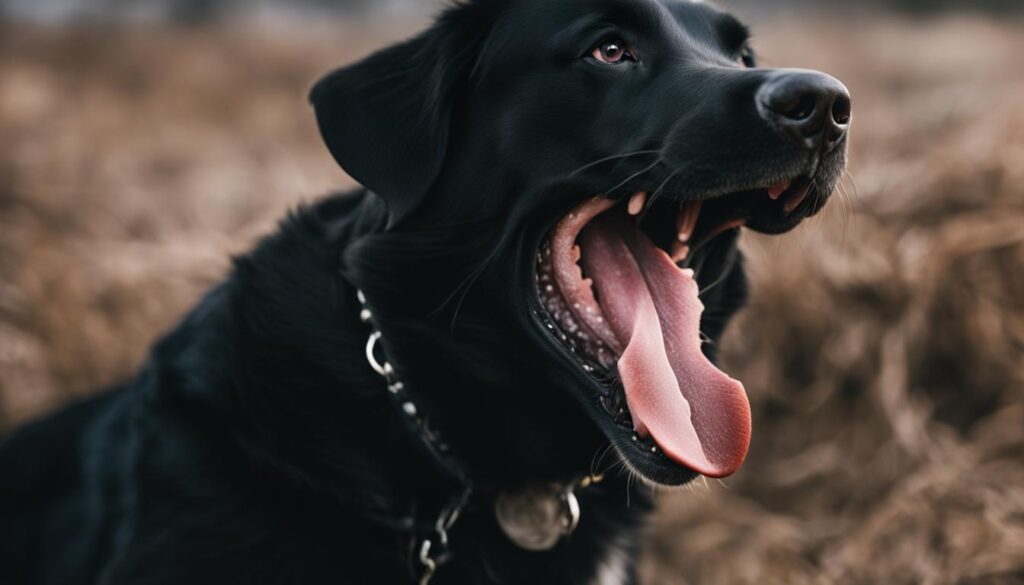Understanding Why Dogs Lick Other Dogs’ Ears
Have you ever wondered why dogs engage in the peculiar behavior of licking each other’s ears? This common canine behavior serves various purposes and can provide valuable insights into their communication and social dynamics.
Ear licking in dogs can be a form of grooming, a way to greet or show affection, or a self-soothing behavior. Understanding the reasons behind this behavior can help dog owners better understand their furry companions and ensure their well-being.
Key Takeaways:
- Dogs lick each other’s ears as a form of grooming and bonding.
- Ear licking can also be a way for dogs to communicate and establish social hierarchy.
- This behavior may serve as a way for dogs to self-soothe when feeling stressed or anxious.
- Excessive ear licking may indicate underlying health issues or stress, requiring intervention.
- Managing and redirecting excessive ear licking can be achieved through training and providing distractions.
Grooming and Bonding Through Ear Licking
One of the fascinating behaviors in dogs is their tendency to lick each other’s ears. While it may seem strange to us humans, this behavior serves a purpose in the canine world. Dogs engage in ear licking as a form of grooming, showing affection, and establishing social bonds.
Dogs share a strong instinct for grooming, and ear licking is an extension of this behavior. It is reminiscent of how a mother dog grooms her puppies and how dogs groom themselves. By licking each other’s ears, dogs help keep their packmates clean and tidy.
Ear licking also plays a crucial role in bonding between dogs. It’s a way for them to show affection and establish a sense of closeness.
This grooming behavior is not just about physical cleanliness; it also has a social dimension. Dogs communicate through various behaviors, and ear licking is one of those modes of communication. When a dog licks another dog’s ears, it conveys specific messages related to social hierarchy and pack dynamics.
By engaging in ear licking, dogs can communicate dominance or submission, depending on their position in the social order. This behavior is an integral part of establishing and maintaining social relationships within a dog pack.
To emphasize the significance of grooming and bonding through ear licking, consider the following:
“Ear licking is a vital behavior in dogs, serving multiple purposes. It not only keeps them clean but also helps to strengthen their emotional connections and maintain social harmony within the pack.”
In summary, ear licking is a behavior that dogs engage in to groom each other, show affection, and communicate their social hierarchy. Understanding the role of grooming and bonding through ear licking allows us to appreciate the intricate social dynamics among dogs and strengthens our bond with our furry friends.
https://www.youtube.com/watch?v=jEzJOLCfWhY
Ear Licking as a Form of Greeting
In dog packs, ear licking serves as a common form of greeting among dogs. This behavior is deeply rooted in their instinctual pack behavior and plays a significant role in establishing social hierarchy within the group.
Dogs lower in the social hierarchy often engage in ear licking to show submission and respect towards more dominant dogs. By licking the ears of their superiors, they display deference and acknowledge their place in the pack’s social structure.
Observing dogs licking each other’s ears can provide valuable insights into the complex social dynamics at play. It showcases the intricate relationships and power dynamics within the group, highlighting the intricate nature of their social hierarchy.
While ear licking is primarily a gesture of submission, it can also be an expression of trust, friendship, and social bonding among dogs. It reinforces the sense of community, cooperation, and camaraderie within the pack.
“In dog packs, ear licking is not simply a random behavior; it is a powerful social signal that speaks volumes about the dynamics of their social order.”
In summary, ear licking among dogs is an important form of communication that goes beyond a simple greeting. It reflects the intricate social hierarchy within the pack, with dominant dogs receiving this gesture of submission from their subordinates. This behavior reminds us of dogs’ ancestral roots and their inherent need for social connection and structure.
| Benefits of Ear Licking as a Form of Greeting | Insights into Social Hierarchy | Expression of Trust and Bonding |
|---|---|---|
| Reinforces pack dynamics | Showcases dominant and submissive roles | Strengthens social bonds |
| Facilitates social cohesion | Establishes clear communication | Builds a sense of community |
Self-Soothing Through Ear Licking
Dogs often engage in ear licking as a form of self-soothing when they are feeling stressed or anxious. Similar to other compulsive behaviors in dogs, such as pacing or spinning, ear licking provides them with a sense of comfort and relief. If you observe a dog excessively licking another dog’s ears, it could be an indication of underlying stress or anxiety that needs attention.
It’s important for dog owners to understand the potential causes of stress in dogs, as they can exhibit various behaviors to cope with it. Ear licking is one such behavior that can serve as a way for dogs to regulate their emotions and find comfort in challenging situations.
To help your dog redirect this self-soothing behavior, providing alternative forms of stimulation is essential. Interactive toys and chew treats can occupy their attention and provide a healthy outlet for their stress. Additionally, engaging your dog in regular physical exercise and mental stimulation can help reduce their overall stress levels.
It’s essential to remember that excessive ear licking can also be a sign of an underlying medical condition. If you notice any changes in your dog’s behavior or suspect that their ear licking is related to a health issue, it’s best to consult with a veterinarian for proper diagnosis and treatment.
Recognizing and addressing your dog’s stress through various methods, including redirecting self-soothing behaviors like ear licking, can contribute to their overall well-being and happiness.

| Common Causes of Stress in Dogs | Signs of Stress in Dogs |
|---|---|
| Anxiety or fear | Excessive panting |
| Change in environment or routine | Increased aggression |
| Loud noises or fireworks | Loss of appetite |
| Separation anxiety | Restlessness or pacing |
| Conflict with other dogs | Excessive barking or whining |
When to Intervene in Ear Licking Behavior
While most ear licking behavior is harmless, there are certain situations where intervention may be necessary. Excessive ear licking can lead to ear infections or irritation. Dogs may also crave the taste of ear wax, which can be problematic if it becomes excessive. Additionally, if a dog being licked has an ear infection, it is important to intervene to prevent the spread of bacteria.
Signs of Excessive Ear Licking
Excessive ear licking in dogs can be identified by observing certain signs and behaviors. These may include:
- Constant and obsessive licking of the ears
- Redness, swelling, or inflammation in the ear area
- Ear odor or discharge
- Scratching or pawing at the ears
If you notice any of these signs, it is important to address the issue promptly to avoid potential complications.
“Excessive ear licking in dogs can lead to ear infections and discomfort for your furry friend. It is crucial to monitor their behavior and intervene when necessary.”
Preventing Excessive Ear Licking
To prevent excessive ear licking in dogs, it is important to address the underlying causes and provide appropriate care. Here are some preventive measures you can take:
- Maintain regular ear hygiene by cleaning your dog’s ears as recommended by your veterinarian.
- Keep your dog’s ears dry and free from excessive moisture, as wet ears are more prone to infections.
- Ensure a healthy diet for your dog, as deficiencies in certain nutrients can contribute to compulsive behaviors.
- Provide appropriate chew toys or treats to satisfy your dog’s oral cravings and redirect their attention.
By implementing these preventive measures, you can help reduce the likelihood of excessive ear licking in your dog.
Potential Causes of Excessive Ear Licking in Dogs
| Cause | Description |
|---|---|
| Allergies | Allergies to certain foods, environmental factors, or substances can lead to itchiness and compulsive licking behavior. |
| Ear Infections | Ear infections can cause discomfort and irritation in dogs’ ears, leading to excessive licking as a response to relieve the pain. |
| Anxiety or Stress | Dogs may engage in excessive licking as a coping mechanism for anxiety or stress. Identifying and addressing the underlying triggers is essential. |
| Boredom | Dogs with insufficient mental and physical stimulation may resort to excessive licking as a form of self-soothing behavior. |

Health Implications and Ear Licking
Excessive ear licking in dogs can have various health implications. It’s important for dog owners to be aware of these risks in order to protect the well-being of their furry friends. Excessive licking can lead to trauma or injury to the ears, increase the risk of infections, and aggravate existing ear conditions. It’s crucial to monitor for signs of infection, irritation, or discomfort to determine if veterinary advice is necessary.
One of the primary health risks of ear licking is the spread of bacteria. Dogs’ mouths contain numerous bacteria, some of which can be harmful if introduced into the ears. When a dog licks another dog’s ears excessively, it can introduce bacteria into the ear canal, increasing the risk of infection. Additionally, dogs with ear infections can transmit the infection to other dogs through ear licking, further spreading the bacteria.
Signs of ear infections in dogs include:
- Head shaking or tilting
- Scratching or rubbing the ears
- Redness or swelling of the ear canal
- Discharge or odor coming from the ear
- Pain or discomfort when the ears are touched
If you notice any of these signs or if your dog’s ear licking behavior becomes excessive, it’s important to consult with a veterinarian. They can examine your dog’s ears, diagnose any infections or underlying conditions, and recommend appropriate treatment.
“Excessive ear licking can lead to health implications, such as trauma or injury to the ears, the spread of infections, or aggravation of existing ear conditions.”
Managing and Preventing Excessive Ear Licking
Excessive ear licking in dogs can be a concerning behavior for dog owners. Fortunately, there are effective strategies to manage and prevent this behavior. By providing distractions, implementing training techniques, and seeking professional guidance, you can address the issue and ensure the well-being of your beloved pet.
Distract and Engage
One way to manage ear licking in dogs is by providing distractions and alternative activities. Interactive toys, treat puzzles, or chew toys can redirect their attention away from licking their ears. Engaging your dog in games or outdoor activities can also help distract them and prevent excessive ear licking. Remember to select toys and treats that are safe and appropriate for your dog’s size and breed.
Training and Reinforcement
Training your dog to stop ear licking requires consistency, patience, and positive reinforcement. Whenever you notice your dog attempting to lick their ears, redirect their attention to a more appropriate behavior or command. Reward and praise them when they comply, reinforcing the desired behavior. Consider enrolling in obedience classes or working with a professional dog trainer to develop effective training techniques tailored to your dog’s needs.
Seek Professional Guidance
If your dog’s ear licking behavior persists or becomes excessive, it may be beneficial to seek the advice of a professional dog trainer or behaviorist. They can evaluate your dog’s specific circumstances and provide expert guidance to address the underlying causes of the behavior. A professional can also help develop a personalized behavior modification plan to effectively manage and prevent ear licking in your dog.
Remember, understanding and managing ear licking behaviors in dogs is crucial for their overall health and well-being. By providing distractions, implementing training techniques, and seeking professional guidance, you can help your dog overcome excessive ear licking and ensure a happier and healthier life for your furry friend.
Conclusion
Understanding the behavior of dogs licking each other’s ears is crucial for dog owners to effectively manage and address this common behavior. While ear licking can serve multiple purposes, such as grooming, greeting, or self-soothing, excessive ear licking may indicate underlying health issues or stress in dogs. By closely monitoring and appropriately managing this behavior, dog owners can ensure the overall well-being and happiness of their beloved pets.
Dogs naturally engage in ear licking as a way to communicate, establish social bonds, and exhibit affection. It is important to recognize the different contexts in which dogs lick each other’s ears to better understand their motivations. This behavior can reflect social hierarchy within a group of dogs or serve as a calming mechanism during times of stress or anxiety.
However, excessive ear licking can have potential health implications, including the spread of infections or the exacerbation of existing ear conditions. It is essential for dog owners to be vigilant in recognizing signs of irritation, discomfort, or persistent ear licking that may warrant veterinary intervention. By addressing any underlying health issues and providing appropriate alternatives for stimulation, dog owners can promote a healthier and happier lifestyle for their canine companions.
FAQ
Why do dogs lick each other’s ears?
Dogs may lick each other’s ears as a form of grooming, a way to greet or show affection, or a self-soothing behavior.
Is ear licking a form of grooming in dogs?
Yes, ear licking in dogs is similar to how a mother dog grooms her puppies or how dogs groom themselves. It is a way for dogs to show affection and bond with each other.
Does ear licking serve a communicative purpose in dogs?
Yes, ear licking can be a way for dogs to communicate and establish social hierarchy within a pack.
How does ear licking function as a form of greeting in dogs?
In dog packs, ear licking is a common form of greeting. Dogs on the lower end of the social hierarchy may lick the ears of more dominant dogs as a display of submission.
Is ear licking in dogs a self-soothing behavior?
Yes, dogs may engage in ear licking as a way to self-soothe when they are feeling stressed or anxious.
Are there any situations where intervention may be necessary for ear licking behavior?
Excessive ear licking in dogs can lead to health implications such as trauma or injury to the ears, the spread of infections, or aggravation of existing ear conditions.
How can excessive ear licking in dogs be managed and prevented?
Dog owners can provide distractions and alternatives such as interactive toys or treat puzzles. Training and positive reinforcement techniques can also be implemented to redirect the behavior.
What should dog owners understand about dogs licking each other’s ears?
Understanding why dogs lick each other’s ears is important for dog owners to properly manage and address this behavior. By monitoring and managing this behavior, dog owners can ensure the well-being of their pets.


